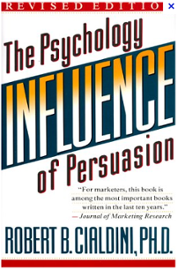One of my favorite marketing books is: “Influence: The Psychology of Persuasion” by Dr. Robert Cialdini. I first read it a few years back and have since re-read it twice. Its message is that powerful… for marketers that is.
 Dr. Cialdini outlines 6 methods of influence and explains why each method works. One of my favorite marketing experts is fond of saying human nature is immutable. It is and has always been the same. Many would argue that today’s modern society has changed human nature but I agree that humans have and continue to have the same basic needs.
Dr. Cialdini outlines 6 methods of influence and explains why each method works. One of my favorite marketing experts is fond of saying human nature is immutable. It is and has always been the same. Many would argue that today’s modern society has changed human nature but I agree that humans have and continue to have the same basic needs.
Which brings us to persuasion and email marketing.
One of the elements of persuasion that is built into human DNA is how we respond to a good deed. Dr. Ciandini calls it reciprocity and good marketers know how to use it to it’s fullest.
It goes like this…
Someone gives you something. You then have a primal, subconcioius, powerful urge to return the favor. No, you don’t feel it and you can’t fight it. It’s just there. Reciprocity.
A few simple examples of reciprocity at work:
– a sales rep buys his prospect lunch
– you are offered a sample in the aisle of your food store
– you sign up for a ‘FREE’ trial
– your neighbor lends you a tool
Each of these events creates in you a need to do something in return. You feel obligated. It’s just there.
How to use reciprocity in your email campaigns.
What is it that you can ‘give’ your email readers? The gambit can range from something simple, like a hint or tip, to something concrete like a free sample or trial account.
Generally speaking if you think of the concept of reciprocity when you are designing your email campaigns, over time you’ll create stronger and stronger desire on behalf of your readers to reciprocate.
It could come back to you in many, many ways.
Reciprocity works the best when you don’t expect something in return. You just let it happen. Human nature doing your marketing for you.
Here’s an example of a reciprocity offer.

